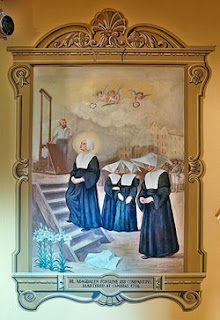SAINTS FOR JULY 17
SAINTS FOR JULY 17
Roman Catholic Carmelite Nuns of Compiegne, Sixteen Carmelites caught up in the French Revolution and martyred.They went to the guillotine singing the Salve Regina. They were beatified in 1906 by Pope St. Pius X. The Carmelites were: Marie Claude Brard; Madeleine Brideau, the subprior; Maire Croissy, grandniece of Colbert Marie Dufour; Marie Hanisset; Marie Meunier, a novice; Rose de Neufville Annette Pebras; Anne Piedcourt: Madeleine Lidoine, the prioress; Angelique Roussel; Catherine Soiron and Therese Soiron, both extern sisters, natives of Compiegne and blood sisters: Anne Mary Thouret; Marie Trezelle; and Eliza beth Verolot. The martyrdom of the nuns was immortalized by the composer Francois Poulenc in his famous opera Dialogues des Carmelites. Feastday July 17
ST. ALEXIUS-Several legends revolve around the figure of St Alexius. He is said to have lived as a beggar under a staircase of his own house, unrecognized by his family. After his death, his identity was discovered, and he was honoured as a saint.
ST. MARCELLINA, VIRGIN, SISTER OF ST. AMBROSE, BISHOP
ST. LEO IV, POPE
St. Turninus, 9th century. Irish priest and missionary. He labored to help evangelize the region of the Netherlands with St. Foillan, especially in the area around Antwerp.
St. Cynllo, 5th century. Welsh saint, patron of churches named in his honor. No records of his life are extant.
St. Fredegand. Benedictine abbot, an Irishman and a companion of St. Foillan. He was abbot of Kerkeloder Abbey, near Antwerp, Belgium, also listed as Fregaut. He also aided St. Willibrord.
St. Kenelm, 821 A.D. Martyred king of Mercia, England. Traditions state that he was the son of King Kenulf, who succeeded to the throne at the age of seven. He was murdered by henchmen of his sister, Cynefrith. Another tradition states that his sister Quendreda bribed his tutor to slay him. He is buried at Winchcombe Abbey, in Gloucestershire. Miracles took place there. Kenelm is now belived to have died before his father. He is mentioned in the Canterbury Tales.


Comments
Post a Comment